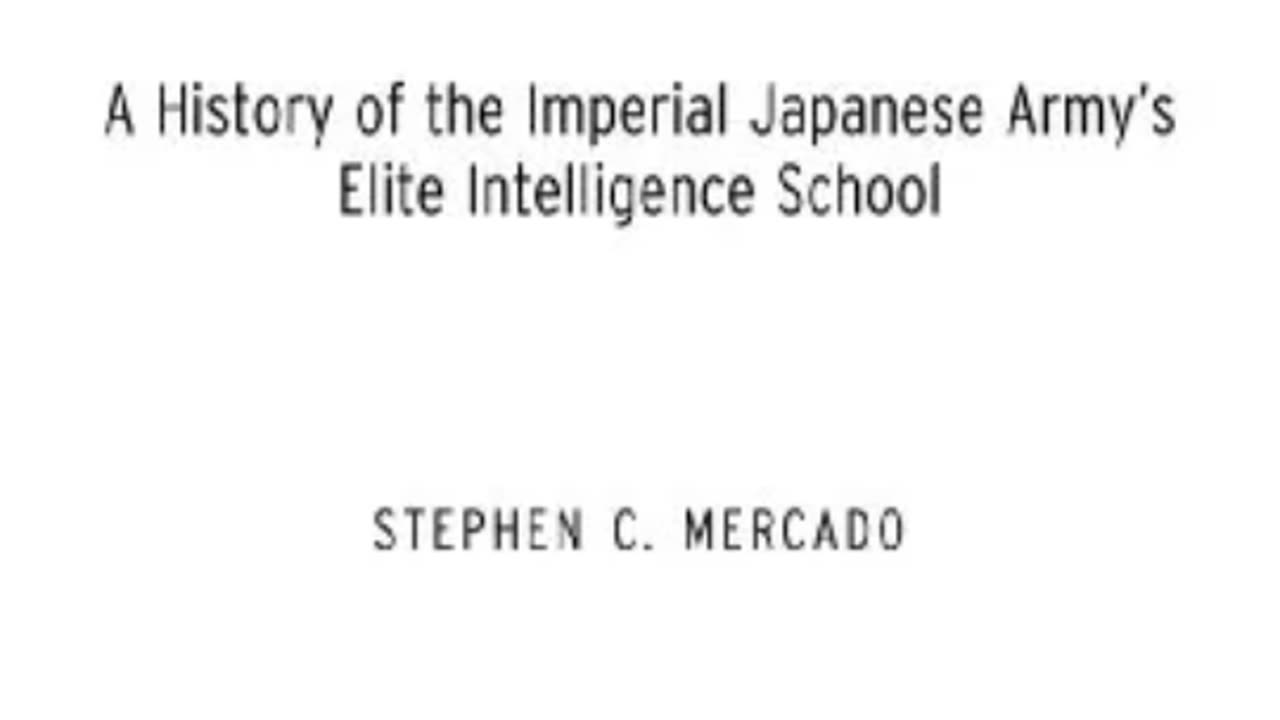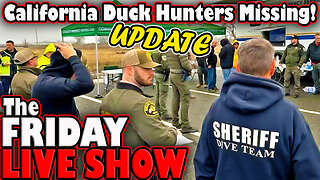Premium Only Content

Nakano Ninja School-Imperial Japanese Intelligence
Pre-World War II:
1868: Japan establishes itself as an imperial power.
1875: Japan gains control of the entire Chishima (Kurile) archipelago.
1894–1895: Sino-Japanese War. Ujina serves as a key military embarkation point.
1905: Russo-Japanese War. Japan gains southern half of Sakhalin (Karafuto).
1918-1922: Japanese Army participates in the Siberian Intervention. First Special Service Agency (SSA) established on the continent.
1920–1925: Japan occupies northern Sakhalin.
1931: Japanese officers seize control of Manchuria.
1934: Japanese authorities in Manchukuo order the construction of collective villages to control anti-Japanese guerillas.
1937: Japan begins undeclared war against China. Yama Agency established for counterintelligence.
1938: The Nakano School, an elite intelligence training facility for the Imperial Japanese Army, is established. Lieutenant General Tojo Hideki visits the school.
1938–1939: Border clashes between Japan and the Soviet Union at Changkufeng and Nomonhan in Manchukuo.
Late 1930s-1945: Japanese forces, aided by Korean auxiliaries, fight against Kim Il-song and other anti-Japanese guerillas in the mountains along the border of Manchukuo and Korea.
1940: War Minister Tojo attends a Nakano School graduation ceremony.
1941:Japan invades French Indochina.
Germany invades the Soviet Union.
Japan considers joining the war against the Soviet Union but ultimately prioritizes the Pacific theater.
Japan attacks Pearl Harbor.
World War II:
1942:Japan invades Southeast Asia.
Nakano School graduates play key roles in intelligence gathering, sabotage, and the formation of pro-Japanese independence movements.
1943: Japanese teachers begin training students in preparation for a potential Allied invasion.
1944:Allied forces begin to push back against Japanese forces in the Pacific.
Imperial General Headquarters establishes a special operations unit to oversee remote-island operations.
The Japanese Army prepares for a final defense of the home islands, including the mobilization of student conscripts into guerrilla units.
1945:Soviet Union declares war on Japan and invades Manchuria.
U.S. drops atomic bombs on Hiroshima and Nagasaki.
Japan surrenders.
Allied occupation of Japan begins.
Post-World War II:
1945–1952:Allied Occupation of Japan.
Many Nakano School graduates are investigated and some are imprisoned as war criminals.
Some Nakano School veterans, like Hattori Takushiro, work for the U.S. occupation forces, providing intelligence on the Soviet Union and China.
The U.S. military begins recruiting former Japanese intelligence officers and utilizing hidden caches of weapons in preparation for the Cold War.
1950–1953:Korean War breaks out.
The U.S. military relies on the expertise of former Japanese intelligence officers and utilizes hidden caches of weapons in Korea.
Former Nakano School instructors are involved in the training of South Korean intelligence officers.
1958: Ne Win, a former member of the Thirty Comrades, seizes power in Burma.
1962: Ne Win leads a coup in Burma and solidifies his power.
1966: Japanese Prime Minister Sato Eisaku welcomes Ne Win on a state visit.
1970s-1990s:Japan experiences a rise in nationalism.
Groups advocate for the return of territories lost to the Soviet Union after WWII.
Former Nakano School graduates are involved in these movements, leveraging their wartime experiences and connections.
1974: Hiroo Onoda, a Japanese soldier who remained hidden in the Philippines since WWII, is found and returns to Japan.
1997: Japan establishes the Defense Intelligence Headquarters (DIH).
Late 1990s:Onoda Hiroo participates in public events and publishes accounts of his wartime experiences.
The legacy of the Nakano School and the role of Japanese intelligence officers during WWII continues to be a subject of interest and debate.
Cast of Characters:
Japanese Military and Intelligence:
Akigusa Shun: A Lieutenant Colonel and Soviet expert, instrumental in establishing the Nakano School.
Anami Korechika: A General who served as War Minister. Supported the establishment of the Nakano School.
Arisue Seizo: A General who served as Chief of Staff of the Burma Area Army and later head of the Iwakuro Agency. Provided valuable intelligence to U.S. forces after the war.
Baba Yoshimitsu: A Captain and Nakano School graduate who served in intelligence in Manchukuo. Imprisoned by the Soviets after the war and later provided intelligence to the U.S.
Fujiwara Iwaichi: A Lieutenant Colonel and key figure in establishing the intelligence network in Southeast Asia before the war (Fujiwara Agency). Involved in training and supporting the Indian National Army (INA). After the war, he became commandant of the Japanese Ground Self-Defense Force (GSDF) Intelligence School.
Hagi Saburo: A Colonel who headed intelligence for the Fifth Area Army responsible for defending against a potential Soviet invasion in the north. He focused on guerrilla warfare preparations in Hokkaido and Sakhalin.
Hattori Takushiro: A Colonel who worked closely with General Willoughby during the Allied occupation, providing intelligence on the Soviet Union. Played a controversial role in shaping Japanese defense policy during the Cold War.
Hirose Hideo: A Lieutenant and Nakano School graduate who served on the staff of the Thirty-second Army in Okinawa. He directed guerrilla operations during the Battle of Okinawa.
Inomata Jinya: A Lieutenant and member of the Nakano School's inaugural class. Gathered intelligence on the Soviet Union and later planned against the Allied occupation of Japan.
Isoda Saburo: A Lieutenant General who led the Iwakuro Agency and later the Hikari Agency, playing a key role in intelligence operations related to India and Southeast Asia during the war.
Iwakuro Hideo: A Lieutenant Colonel and a founder of the Nakano School. He later headed the Iwakuro Agency, focusing on intelligence and operations related to India's independence movement.
Kawabe Torashiro: A Lieutenant General and experienced intelligence officer. Headed the Japanese mission to Manila for the Manila Conference with General MacArthur’s staff.
Kawashima Takenobu: A Captain and Nakano School graduate who served in the Minami Agency, supporting Burmese independence. He later achieved the rank of Major General in the post-war Japanese Ground Self-Defense Force (GSDF).
Kimura Takechiyo: A Lieutenant and Nakano School graduate tasked with gathering intelligence on the United States.
Kuriya Tsugunori: A Nakano School graduate who served in the Japanese consulate in Batavia (Jakarta) and was involved in pre-war intelligence gathering in the Dutch East Indies.
Murakami Haruo: A Lieutenant who parachuted into Okinawa ahead of the U.S. invasion to organize guerrilla resistance.
Muta Teruo: A Captain and Nakano School graduate who played a crucial role in training guerrilla units and developing tactics for resisting a potential Soviet invasion in northern Japan.
Onoda Hiroo: A Lieutenant and Nakano School graduate famous for remaining hidden on Lubang Island in the Philippines for three decades after WWII, refusing to believe the war was over.
Sakai Kiyoshi: A Sergeant and Nakano School graduate dispatched to Hateruma Island to prepare defenses and organize guerrilla resistance.
Suzuki Keiji: A Colonel who led the Minami Agency and trained the Thirty Comrades, including Aung San and Ne Win, who later played key roles in Burma's independence.
Tani Yutaka (Harimao): A Japanese-born Malaysian recruited by the Fujiwara Agency for his knowledge of Malaya and connections with local communities. He organized a guerrilla force that supported the Japanese invasion of Malaya.
Tarora Sadao: A Lieutenant and Nakano School graduate who used radio deception tactics against Allied forces in Southeast Asia.
Yamamoto Kiyokatsu: A Major and Nakano School instructor who later served as deputy commandant at the GSDF Intelligence School.
Other Key Figures:
Aung San: A Burmese nationalist leader who trained under Suzuki Keiji and later led Burma to independence.
Chiang Kai-shek: Leader of the Chinese Nationalist Government.
Kim Il-song: A Korean communist guerrilla leader who fought against the Japanese in Manchuria and later became the leader of North Korea.
Kobayashi Ichizo: Japanese Trade Minister who attempted to secure oil exports from the Dutch East Indies.
Konoe Fumimaro: Prime Minister of Japan who sought to secure resources from Southeast Asia.
MacArthur, Douglas: Supreme Commander for the Allied Powers (SCAP) during the occupation of Japan.
Molotov, Vyacheslav: Soviet Foreign Minister who informed Japan of the Soviet Union's decision not to renew their neutrality pact.
Ne Win: A Burmese military leader and member of the Thirty Comrades who seized power in Burma after independence.
Subhas Chandra Bose: An Indian nationalist leader who collaborated with the Japanese to form the INA.
Suetsugu Ichiro: A prominent figure in post-war Japan who advocated for the repatriation of Japanese prisoners of war and the return of territories seized by the Soviet Union.
Willoughby, Charles: An American intelligence officer who worked closely with Japanese counterparts during the Allied occupation.
This timeline and cast of characters offer a glimpse into the complex and often clandestine world of Japanese intelligence operations before, during, and after World War II. The Nakano School played a central role in training individuals who would go on to shape history, both within Japan and on the international stage.
-
 1:02:30
1:02:30
Exploring With Nug
10 hours ago $0.83 earned2 Duck Hunters Missing After Kayak Capsizes!
15.1K -
 46:48
46:48
Mally_Mouse
3 hours agoLet's Hang!! -- Opening Christmas gifts from YOU!
36.2K -
 44:55
44:55
Athlete & Artist Show
20 days ago $1.69 earnedNHL 4 Nations Snubs, Was Hawk Tuah Coin A Scam?
32.3K -
 33:47
33:47
Stephen Gardner
9 hours ago🔥Pentagon Whistleblower UNLEASHES on Biden and Obama!
88.9K145 -
 2:20:30
2:20:30
The Dilley Show
10 hours ago $25.10 earnedRoger Stone in Studio plus Q&A Friday! w/Author Brenden Dilley 12/27/2024
81.9K16 -
 1:57:02
1:57:02
The Charlie Kirk Show
8 hours agoThe Great H-1B Battle + AMA | Lomez | 12.27.24
163K209 -
 11:39
11:39
Russell Brand
1 day agoWhat You're Not Being Told About The Syrian War
161K241 -
 DVR
DVR
Bannons War Room
1 year agoWarRoom Live
101M -
 1:49:21
1:49:21
Film Threat
11 hours agoBEST AND WORST OF 2024 + SQUID GAME SEASON 2 | Film Threat Livecast
60.7K6 -
 1:06:04
1:06:04
The Big Mig™
1 day agoGlobal Finance Forum Powered By Genesis Gold Group
49K2